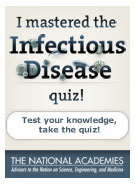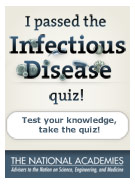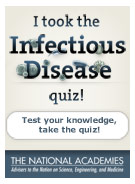
What You Need To Know About Infectious Disease
What do you know about infectious disease?
Which deadly pathogen cannot be found naturally in the wild:
-
Sorry, that’s incorrect.
Smallpox cannot be found naturally in the wild. Smallpox was officially declared eradicated from the globe in 1980, after an 11-year WHO vaccination campaign—the first human disease to be eliminated as a naturally spread contagion. Today, the virus remains only in laboratory stockpiles.
-
Sorry, that’s incorrect.
Smallpox cannot be found naturally in the wild. Smallpox was officially declared eradicated from the globe in 1980, after an 11-year WHO vaccination campaign—the first human disease to be eliminated as a naturally spread contagion. Today, the virus remains only in laboratory stockpiles.
-
Correct!
Smallpox cannot be found naturally in the wild. Smallpox was officially declared eradicated from the globe in 1980, after an 11-year WHO vaccination campaign—the first human disease to be eliminated as a naturally spread contagion. Today, the virus remains only in laboratory stockpiles.
About how much of its fish and seafood does the United States import?
-
Sorry, that’s incorrect.
The United States imports more than 80 percent of its fish and seafood. About 20 percent of its fresh vegetables and 50 percent of its fresh fruits are imported. As wealthy nations demand such foods year-round, the increasing reliance on producers abroad means that food may be contaminated during harvesting, storage, processing, and transport—long before it reaches overseas markets.
-
Sorry, that’s incorrect.
The United States imports more than 80 percent of its fish and seafood. About 20 percent of its fresh vegetables and 50 percent of its fresh fruits are imported. As wealthy nations demand such foods year-round, the increasing reliance on producers abroad means that food may be contaminated during harvesting, storage, processing, and transport—long before it reaches overseas markets.
-
Correct!
The United States imports more than 80 percent of its fish and seafood. About 20 percent of its fresh vegetables and 50 percent of its fresh fruits are imported. As wealthy nations demand such foods year-round, the increasing reliance on producers abroad means that food may be contaminated during harvesting, storage, processing, and transport—long before it reaches overseas markets.
About what percentage of the antibiotics produced in the United States is added to animal feeds to promote growth?
-
Sorry, that’s incorrect.
Almost 70% of all the antibiotics produced in the United States is added to animal feeds—not to fend off disease but to boost growth. These non-therapeutic uses of antibiotics are a perfect way to cultivate microbes that are resistant to antibiotics.
-
Sorry, that’s incorrect.
Almost 70% of all the antibiotics produced in the United States is added to animal feeds—not to fend off disease but to boost growth. These non-therapeutic uses of antibiotics are a perfect way to cultivate microbes that are resistant to antibiotics.
-
Correct!
Almost 70% of all the antibiotics produced in the United States is added to animal feeds—not to fend off disease but to boost growth. These non-therapeutic uses of antibiotics are a perfect way to cultivate microbes that are resistant to antibiotics.
Which are larger?
-
Correct!
Bacteria are 10 to 100 times larger than viruses.
-
Sorry, that’s incorrect.
Bacteria are 10 to 100 times larger than viruses.
The human papillomavirus (HPV) causes about what percentage of cervical cancer cases?
-
Sorry, that’s incorrect.
The human papillomavirus (HPV) causes more than 90% of cervical cancer cases.
-
Sorry, that’s incorrect.
The human papillomavirus (HPV) causes more than 90% of cervical cancer cases.
-
Correct!
The human papillomavirus (HPV) causes more than 90% of cervical cancer cases.
Public health officials can identify the outbreak of disease by monitoring certain patterns of behavior through syndromic surveillance. Which of the following is one of the signs used to identify a disease outbreak using this system?
- Level of school and work absenteeism
- Sales of over-the-counter medication
- Number of illness-related 911 calls
- All of the above
-
Sorry, that’s incorrect.
In syndromic surveillance, all of the above are used in addition to other patterns that suggest an outbreak. Despite the emergence of this innovative surveillance method, most surveillance still depends on tracking reported infections.
-
Sorry, that’s incorrect.
In syndromic surveillance, all of the above are used in addition to other patterns that suggest an outbreak. Despite the emergence of this innovative surveillance method, most surveillance still depends on tracking reported infections.
-
Sorry, that’s incorrect.
In syndromic surveillance, all of the above are used in addition to other patterns that suggest an outbreak. Despite the emergence of this innovative surveillance method, most surveillance still depends on tracking reported infections.
-
Correct!
In syndromic surveillance, all of the above are used in addition to other patterns that suggest an outbreak. Despite the emergence of this innovative surveillance method, most surveillance still depends on tracking reported infections.
Which of the following can be treated with antibiotics?
-
Sorry, that’s incorrect.
Strep throat is a bacterial infection that can be treated with antibiotics. The common cold and influenza are both viral infections, which do not respond to antibiotics. Antivirals may be prescribed instead.
-
Correct!
Strep throat is a bacterial infection that can be treated with antibiotics. The common cold and influenza are both viral infections, which do not respond to antibiotics. Antivirals may be prescribed instead.
-
Sorry, that’s incorrect.
Strep throat is a bacterial infection that can be treated with antibiotics. The common cold and influenza are both viral infections, which do not respond to antibiotics. Antivirals may be prescribed instead.
-
Sorry, that’s incorrect.
Strep throat is a bacterial infection that can be treated with antibiotics. The common cold and influenza are both viral infections, which do not respond to antibiotics. Antivirals may be prescribed instead.
Which of these viral diseases has the most antiviral drugs available to treat it?
-
Sorry, that’s incorrect.
Today there are more antiviral drugs available for HIV than for any other viral disease, transforming an infection that was once considered a death sentence into a manageable chronic condition.
-
Correct!
Today there are more antiviral drugs available for HIV than for any other viral disease, transforming an infection that was once considered a death sentence into a manageable chronic condition.
-
Sorry, that’s incorrect.
Today there are more antiviral drugs available for HIV than for any other viral disease, transforming an infection that was once considered a death sentence into a manageable chronic condition.
-
Sorry, that’s incorrect.
Today there are more antiviral drugs available for HIV than for any other viral disease, transforming an infection that was once considered a death sentence into a manageable chronic condition.
Which of the following global events does NOT have an impact on the spread of infectious disease:
-
Sorry, that’s incorrect.
The expanded use of cell phones does not have an impact on the spread of infectious disease. Climate change, ecosystem disturbances, war, poverty, migration, and global trade all contribute to the spread of infectious disease.
-
Correct!
The expanded use of cell phones does not have an impact on the spread of infectious disease. Climate change, ecosystem disturbances, war, poverty, migration, and global trade all contribute to the spread of infectious disease.
-
Sorry, that’s incorrect.
The expanded use of cell phones does not have an impact on the spread of infectious disease. Climate change, ecosystem disturbances, war, poverty, migration, and global trade all contribute to the spread of infectious disease.
-
Sorry, that’s incorrect.
The expanded use of cell phones does not have an impact on the spread of infectious disease. Climate change, ecosystem disturbances, war, poverty, migration, and global trade all contribute to the spread of infectious disease.
Thank you for taking our quiz.
Place this badge on your Facebook page to show your friends what you know about infectious disease.
Place this badge on your Facebook page to show your friends what you know about infectious disease.
OR, get a higher score to unlock a different badge.
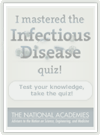
Place this badge on your Facebook page to show your friends what you know about infectious disease.
OR, get a higher score to unlock a different badge.
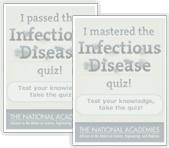
Explore Other Topics
Disease Watchlist
Infectious Disease Defined
- Fertilized Egg
Sometimes referred to as a zygote, this is the resulting initial cell formed when a sperm cell unites with an egg cell.
